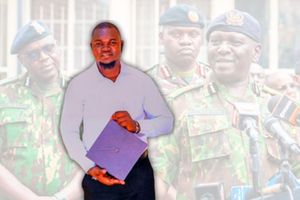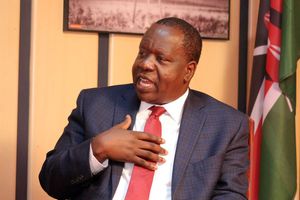
Two vehicles torched amid protests on June 12th 2025 along Nkrumah Lane in Nairobi.
Growing calls to apprehend the killers of a teacher murdered in police custody snowballed into a national security crisis on Thursday that plunged Nairobi city centre into hours of chaos.
The violent protests that saw vehicles torched as tensions following the killing of Albert Ojwang boiled over coincided with the morning appearance in Parliament by security chiefs for the second day in a row as MPs probed the murder.
Clashes between protestors and police also overshadowed the reading of the budget in Parliament in the afternoon by Treasury Cabinet Secretary John Mbadi, who was making his debut financial presentation since his appointment to cabinet last year.
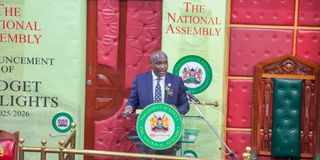
National Treasury Cabinet Secretary John Mbadi at Parliament buildings, Nairobi on June 12, 2025 during the budget reading.
Bursts of gunfire echoed across the city with plumes of teargas rising towards the cloudy skyline as Mr Mbadi read his speech to a House that had many empty seats, perhaps the violence forcing most MPs to stay away given their horror experience last June when riots forced them to scamper to safety through an underground tunnel.
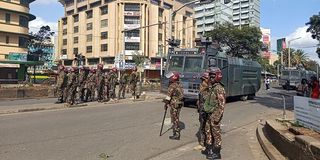
Police officers patrol Nairobi CBD during protests.
Mr Mbadi was among five opposition figures appointed to the cabinet last June following a deal between President Ruto and opposition leader Raila Odinga after his administration was shaken to the core by youth protests that culminated in the deadly invasion of Parliament.
And a fortnight to the first anniversary of the Gen Z riots that led to the killing by security agents of scores of protesters and forced the government to withdraw a draconian Bill that contained a slew of punitive taxes, protestors were back in the streets on Thursday, engaging police in running battles to demand justice for Ojwang, a teacher-cum-blogger.
The morning began with a strange stillness and not the quiet of anticipation that usually accompanies the ritual of budget reading. An uneasy calm before a storm.
Calls for justice
The streets buzzed not with economic forecasts or murmurs of fuel levies, but with outrage —raw, righteous, and surging.
It was no longer just about numbers on paper. A murdered teacher —young, gentle, a nurturer of children’s minds— had become the face of national grief. His story had lit a firestorm online. But by Thursday, that fire had burst from screens into the city’s streets, consuming everything in its path, even the long-standing reverence for the annual budget ritual.
At 12:20pm, a handful of protestors started gathering along Haile Selassie Avenue and engaged police officers attempting to march into the government square.
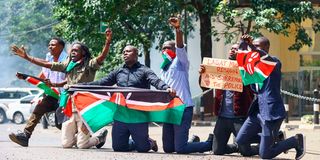
Protesters march along Harambee Avenue, Nairobi on June 12, 2025. They demanded justice for Albert Ojwang, who died in police custody last weekend.
Ten minutes later, as their numbers swelled, they began marching towards the Treasury building, aiming to block Mr Mbadi from leaving for Parliament to present the budget estimates and government revenue.
This strategy was, however, thwarted by police officers who lobbed several teargas cannisters at them, forcing them back towards Moi Avenue as some cut through Aga Khan walk towards Kencom along City Hall Way.
At 1:30pm, Mr Mbadi, amidst teargas fumes, left his office and, together with a music band and his entourage, began his walk to Parliament.
A tight security cordon had been thrown around the government square, an iron-clad buffer zone along Harambee Avenue where the Treasury ministry boss and his delegation walked before taking a right turn at the roundabout on Parliament Road.
Television stations interrupted the coverage to capture glimpses of the swelling unrest outside. On television, a split screen showed the scripted, neat language of fiscal policy on one side, and the fraying order of Nairobi on the other.
Then came the attempt to reach Jogoo House —the symbolic heart of police authority, where Deputy Inspector General Eliud Lagat, the officer now synonymous with this public anger, keeps his office. The protests turned volatile. Lines of riot police held their ground. Sirens wailed. Tear gas canisters hissed through the air. The tension, until then tightly held, finally snapped.
With their initial strategy to barricade the Treasury CS from leaving his office thwarted, the angry protestors marched towards Kenyatta Avenue. This was 1:40 pm. They sought to storm Parliament, and if possible, disrupt the budget reading.
But before getting there, the youth opted for fanfare. With whistles, the Kenyan flag and twigs, they sang, and danced and chanted songs of bravery and defiance.

Police officers approach a protester sitting in the middle of the road along Moi Avenue in Nairobi on June 12, 2025.
Towards 2pm, chaos ruled the city, especially around The National Archives, Moi Avenue, Tom Mboya Street and Ronald Ngala Street. Water cannons roared like engines of war. The acrid sting of tear gas hung low, burning eyes, throats, and hopes alike.
Just behind the Kenya Cinema, two vehicles with registration numbers KAR 936D and KBR 954G were torched.
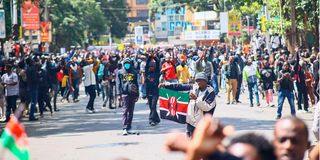
Demonstrators along Harambee Avenue on June 12, 2025, protested and demanded justice over the death of Albert Ojwang, who died in police custody last weekend.
The Nation Research Desk can, however, dispel the rumours casting doubts about their ownership registration details. A search at the National Transport and Safety Authority portal revealed their owners. The KBR, a white Toyota station wagon, is owned by Wells Fargo.
The other one is owned by a private individual whose name we will not publish for legal reasons. The vehicle, a Toyota AE110, was registered on September 19, 2003.
Also Read: Senators accuse IG Kanja of cover-up
Businesses remained shut around these areas. Windows and doors of some establishments were vandalised across the city.
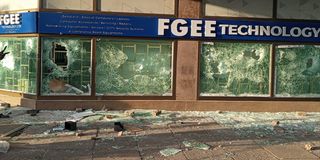
Several properties in the Nairobi Central Business District were damaged by goons who infiltrated street protests against murder of teacher and blogger Albert Ojwang.
Office workers peered out from high-rise windows, unsure when—or if— they’d get home. And then the second wave of paralysis struck.
Casualties
At least one police officer was injured, the Nairobi Region Police Commander George Seda told the Nation.
"No civilian has been injured so far. We've completely restrained. We're just using water and teargas."
But several videos online showed bloodied civilians injured from the melee that ensued.
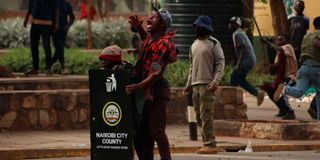
Demonstrators shielding themselves from tear gas canisters that were being lobbed by police officers towards them along Harambee Avenue in Nairobi on June 12, 2025, during protests over the death of a blogger and a teacher, Albert Ojwang.
“The bullet has been removed, but I’m having a terrible headache,” Lucy Nelima, who was injured in the chaos, said. “I was hit around 1.30pm around Harambee Avenue.”
Of all the chants sang on Thursday, the loudest was simple: “No justice, no budget”.
“How can we be happy when the budget that will allocate more money to the same police who kill us every day is being read today? We do not want that budget to be read, we want justice. No justice, no budget,” one of the protestors said.
By 1:51pm, Kenyatta Avenue was effectively blocked as the demonstrators used the cabro from the sidewalks to hamper transportation on the typically busy road. Matatu drivers, sensing the unrest, stepped on the brakes, reversed and headed back towards the direction of the General Post Office, causing more chaos.
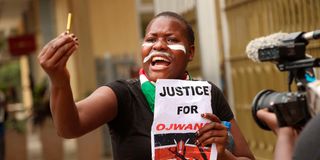
A demonstrator along Harambee Avenue in Nairobi on June 12, 2025, during protests over the death of a blogger and a teacher, Albert Ojwang, who died in Central police station.
On the protestors marched, eyes trailed to the junction of Kenyatta Avenue and Koinange Street where they paused for a few citations and more songs. At this point, one of them, holding a front page of a newspaper showing the face of DIG Lagat, stoked the anger of the protestors who went on a frenzy, shouting “Lagat must go!
The chants died down and were effectively replaced with the solemn songs of patriotism. The national anthem commenced, everyone, including those hurling stones and cursing the Parliament, halted their workings and placed their hands on their chests. Their voices went several notches higher at the second stanza which they sang in Kiswahili.
“Amkeni ndugu zetu, tufanye sote bidi,nasi tujitoe kwa nguvu…Nchi yetu ya Kenya, tunayoipenda- tuwe tayari kuilinda,”
Let one and all arise, with hearts both strong and true…Service be our earnest endeavour, and our homeland of Kenya. Heritage and splendour, Firm may we stand to defend!”
Then on they trudged towards Koinange Street, then Kaunda Street at the Cardinal Otunga Plaza, where they took a right turn and headed to Parliament Road.
Also Read: The men with answers on Ojwang’s death
Previously unfettered by the police, the group, numbering a few hundreds, was surprised to find a contingent of anti-riot police, armed to the teeth, awaiting their arrival.
Teargas canisters were lobbed in plenty, but unrelenting, the protesters hurled more stones at the police officers.
However, police repelled them back to Kenyatta Avenue and Standard Street, where they regrouped and headed to Mama Ngina Street and later on, resurfaced at City Hall Way.
As if anticipating this move, the officers barricaded the roundabout at Wabera Street as well as Taifa Road to prevent any procession to either the Supreme Court, City Hall as well as Jogoo House and Vigilance House, which houses senior police officers of the land.
With this newfound impasse, the protesters landed on the iron sheets fencing the construction site at the Kencom bus stop, plucked them off, then used them to barricade themselves from the torrents of teargas coming their way. The time was 3:10pm.
Tired of the cat and mouse games, the police officers, in an explosive show of power, rained teargas on the demonstrators, who, sensing the change in tone, took off. The officers then managed to put off the fire that had been started behind the iron sheets barricade.
This did not daunt the spirits of the young protesters who relocated their fury to Moi Avenue. Here, they kept the police who were blocking them from accessing University Way en route to Central Police Station, where the late Ojwang died from assault and strangulation last Sunday morning.
By nightfall, sporadic sounds of teargas canisters could be heard across several streets and avenues, with chants of “no justice, no budget, no peace” following.
Rush hour came, but Nairobi stood still.
“I’ve tried accessing the bus terminus, but it is impossible to get there. I’m walking back to the office until it hopefully cools off,” a stranded Lynn Mwendwa said.
At Kencom, Railways, Commercial- names that once meant the promise of motion, especially in the evening- there was nothing. Buses were scarce, matatus nowhere to be seen. Many crews had parked, unwilling to brave streets now teeming with riot police and flying projectiles. Others had fled when things turned nasty, tyres screeching, doors half-closed.
Hundreds of commuters stood stranded. Some walked, trudging for hours to estates miles away.



